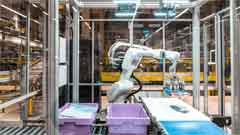As announced in company blog post Friday, Amazon is adding to its existing warehouse robotics capabilities with a deal Covariant, a California-based developer of robots for distribution.
According to Amazon, it is hiring three Covariant founders, Peter Chen, Pieter Abbeel, and Rocky Duan. What’s more, some 25% of Covariant’s current 160 employees are expecting to join Amazon. All this despite the fact the Covariant is expected to continue as an independent company.
Supply Chain Digest Says... |
|
|
In addition to the personal moves, as part of the deal, Amazon will receive a non-exclusive license to Covariant’s AI models.
The deal is similar to one that Amazon struck in June, according to GeekWire, when it agree to hire the founders of Adept, a startup building AI agents that automate enterprise workflows.
Again similar to the Covariant deal, Amazon also reached a technology licensing deal with Adept, and about a third of Adept’s employees joined Amazon at the time.
These deals are essentially “reverse acquihires,” said Alex Heath, deputy editor at The Verge, in a post in July, describing the combination of hiring and licensing as acquisitions in disguise.
Covariant, founded in 2017, focuses on AI-powered robotics systems in distribution centers for order picking, sortation, depalletization and more. The robots leverage a platform that it calls the “Covariant Brain.”
On its web site, Covariant says its robot customers include healthcare supply manufacturer McKesson, German retail giant Otto Group, and Radial, an e-commerce 3PL.
In July, Bloomberg News reported that Covariant had received “takeover interest”
from Amazon, noting that its platform could help Amazon centralize management of its fulfillment center automation robots.
In 2012, Amazon’s moveinto warehouse robotics started with its acquisition of Kiva Systems, a maker of “goods-to-person” robotic system, for some $700 million.
Since then, Amazon has developed a series of warehouse robots of its own across its operations, such as for “pick and place” applications.
As the robots have been deployed by the tens of thousands, Amazon has faced increased scrutiny over worker safety.
(See More Below)
|
CATEGORY SPONSOR: SOFTEON |
|
|
| |
|
|
 A widely cited 2019 report by the Center for Investigative Journalism showed a higher injury rate at Amazon’s robotic fulfillment centers than at its older facilities at the time, indicating that human workers were struggling to keep up. A widely cited 2019 report by the Center for Investigative Journalism showed a higher injury rate at Amazon’s robotic fulfillment centers than at its older facilities at the time, indicating that human workers were struggling to keep up.
Amazon has disputed the notion that robots boost injury rates. Recordable incident rates and lost-time incident rates were 15% and 18% lower, respectively, at Amazon Robotics sites than they were at its non-robotics sites in 2022, according to numbers released by the company last year.
“I want to eliminate the mundane, and the tedious, and the repetitive,” said Ty Brady, the chief technologist for Amazon Robotics, in a 2023 interview with GeekWire. “I want to make things safer inside our fulfillment centers. I don’t want folks to have to lift heavy boxes and crouch down on their knees or reach over their shoulders. And if we can have robotic systems to do that, that’s a win for everybody.”
Financial terms of Amazon’s AI licensing deal with Covariant were not disclosed.
Do you have any comments on Amazon news? Let us know your thoughts at the Feedback button below (email) or in the Feedback section.
|